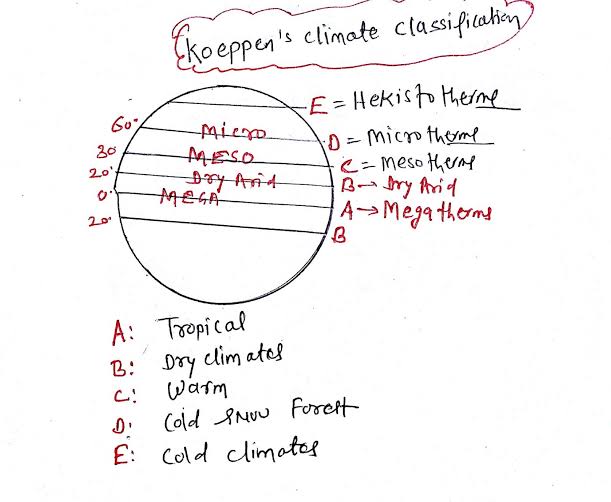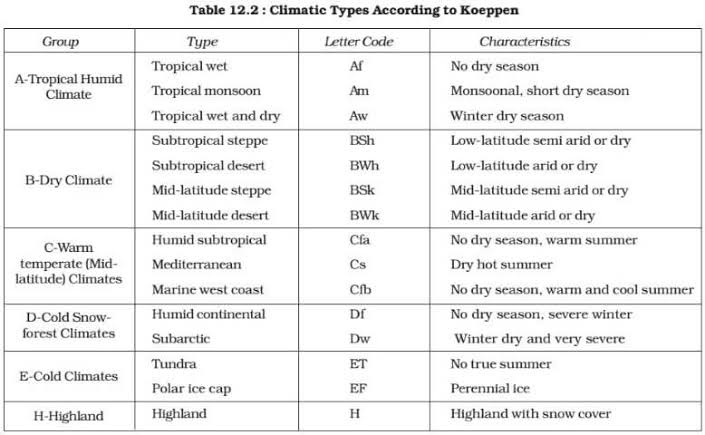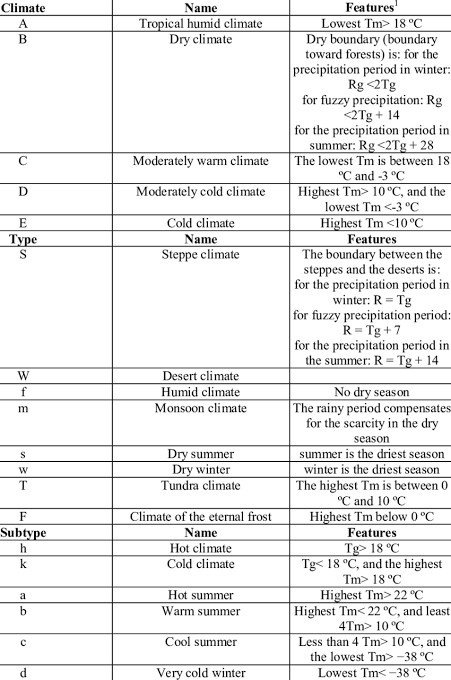
Table of Contents
- 1 Differences between weather and climate
- 2 List of climatic groups and their characteristics according to Koeppen
- 3 Climatic Types According to Koeppen
- 4 System of Koppen Climate Classification
- 5 A- Tropical, Moist climates
- 6 B – Dry Climates
- 7 C – Moist Sub-tropical Mid-latitude Climates
- 8 Climate Type D: Moist Continental Mid-latitude Climates
- 9 E – Polar Climates
- 10 Koppen Classification’s benefits
- 11 Koppen Classification’s drawbacks
Differences between weather and climate
| Climate | Weather | |
| Definition | Describes the average conditions expected at a specific place at a given time (considerable time). A region’s climate is generated by the climate system, which has five components: atmosphere, hydrosphere, cryosphere, land surface, and biosphere. | Describes the atmospheric conditions at a specific place at a specific point in time. Weather generally refers to day-to-day temperature and precipitation activity |
| Components | Climate may include precipitation, temperature, humidity, sunshine, wind velocity, phenomena such as fog, frost, and hail storms over a long period of time. | Weather includes sunshine, rain, cloud cover, winds, hail, snow, sleet, freezing rain, flooding, blizzards, ice storms, thunderstorms, steady rains from a cold front or warm front, excessive heat, heat waves and more |
| Forecast | By aggregates of weather statistics over periods of 30 years | By collecting meteorological data, like air temperature, pressure, humidity, solar radiation, wind speeds and direction etc. |
| Determining factors | Aggregating weather statistics over periods of 30 years (“climate normals”). | Real-time measurements of atmospheric pressure, temperature, wind speed and direction, humidity, precipitation, cloud cover, and other variables |
| About | Climate is defined as statistical weather information that describes the variation of weather at a given place for a specified interval. | Weather is the day-to-day state of the atmosphere, and its short-term (minutes to weeks) variation |
| Time period | Measured over a long period | Measured for short term |
| Study | Climatology | Meteorology |
List of climatic groups and their characteristics according to Koeppen

| Group | Characteristics |
| A- Tropical | The average temperature of the coldest month is 18° C or higher |
| B- Dry Climates | Potential evaporation exceeds precipitation |
| C- Warm Temperate | The average temperature of the coldest month of the (Mid-latitude) climates years is higher than minus 3°C but below 18°C |
| D- Cold Snow forest | The average temperature of the coldest month is minus 3° C or below |
| E- Cold Climates | Cold Climates Average temperature for all months is below 10° C |
| H- Highlands | Cold due to elevation |
Climatic Types According to Koeppen

| Group | Type | Letter Code | Characteristics |
| A-Tropical Humid Climate | Tropical WetTropical MonsoonTropical wet and dry | AfAmAw | No dry seasonMonsoonal, Short dry seasonWinter dry season |
| B-Dry Climate | Subtropical SteppeSubtropical DesertMid-latitude SteppeMid-latitude Desert | BShBWhBSkBWk | Low-latitude semi-arid or dryLow-latitude arid or dryMid-latitude semi-arid or dryMid-latitude arid or dry |
| C-Warm temperate Climates | Humid subtropicalMediterraneanMarine west coast | CfaCsCfb | No dry seasonDry hot summerNo dry season, warm and cool summer |
| D- Cold Snow-forest Climates | Humid Continental Subarctic | DfDw | No dry season, severe winterWinter dry and very severe |
| E-Cold climates | TundraPolar ice cap | ETEF | No true summerPerennial ice |
| H-highland | Highland | H | Highland with snow cover |
The Koppen Climate Classification System is by far the most popular system for describing current climatic conditions.
Let’s learn more about the Koeppen categorization system for climate. In order to categorise the world’s climate, Wladimir Köppen—basically a Russian-German climatologist—found a strong correlation between a region’s vegetation and its climate.
He wanted to create a chart with calculations and notations that would define the climatic boundaries and indicate how closely they matched the flora that was already present.
To put it simply, he observed the trees and plants in a certain area before determining how the vegetation and climate there interacted. By establishing a strong correlation between the two, he was able to develop a chart that grouped various climates according to their distinctive characteristics.
In order to categorise the climates, he chose specific temperature and precipitation values, connected them to vegetation distribution, and used those values.
He assigned the capital letters A, B, C, D, E, and H to categorise every climate in the globe. By using little letters like a, b, c, d, h, f, m, w, k, and s, these categories are further broken down into types and subdivisions.
But first, let’s look at the distinctions between weather and climate before we get into more detail on the Koppen Climate Classification System.
System of Koppen Climate Classification
Wladimir Köppen was a German climatologist and amateur botanist who was born in Russia and lived from 1846 to 1940. His name is pronounced “kur-pin” with a silent r.
His system of categorising climates originally debuted in 1918, and over the rest of his life, he revised and updated it, with the final version appearing in 1936.
In addition to the unique category of highland (H) climate, the modified Köppen system describes five primary climate groups (groups A, B, C, D, and E), which are further classified into a total of 14 specific climate types.
Four of the five major climatic groupings that Koeppen identified are based on temperature, while one is based on precipitation.
- Humid climates are designated by the capital letters A, C, D, and E, while dry climates are indicated by B.
- The seasonality of precipitation and temperature features are used to further categorise the climatic groups into kinds, which are denoted by little letters.
- The little letters “f,” “m,” “w,” and “s” stand for “no dry season,” “monsoon climate,” “winter dry season,” and “summer dry season,” respectively, to denote the seasons of dryness.
- The basic climatic kinds previously described are further separated based on the seasonal distribution of rainfall or amount of dryness or cold.
a: hot summer, with the warmest month’s average temperature exceeding 22°C
c: cold summer, with the warmest month’s average temperature falling below 22°C.
No dry season (f)
Dry season in winter: w; dry season in summer: s
The hottest month occurs before the solstice and the summer rainy season. g: Gange’s type of yearly temperature march.
h: yearly average temperature below 18°C
m: Monsoon: a brief dry season.
The two subtypes of dry climate, semi-arid or Steppe (S) and arid or desert (W), are denoted by the capital letters S and W. - The two polar climate divisions, tundra (T) and icecap (F), are both denoted by the capital letters T and F.
A- Tropical, Moist climates
Around 15 to 25 degrees latitude north and south of the equator are where you can find tropical moist climates. This climatic zone is characterised by consistently high temperatures above 18 degrees Celsius throughout the year. In this climatic zone, annual precipitation is typically greater than 1,500 mm.
Three minor climactic kinds also occur within this wide climatic zone; these types are categorised based on the seasonal distribution of rainfall within these climatic zones. These climate zones are typically characterised by naturally dense tropical woods.
The first is Af, or tropical wet climate, where there is year-round precipitation and a tropical climate.
- In these areas, the monthly temperature variance is less than or equal to 3 degrees C.
- Cumulus and cumulonimbus clouds grow early into the afternoons every day in these areas due to the exceptionally high humidity and surface temperatures, which leads to a large amount of precipitation.
The second is classified as Am, a tropical monsoon climate. - The yearly precipitation in these areas is almost same to that in Af, although most of it falls during the 7 to 9 warmest months of the year.
- The rest of the year sees less rain in these areas.
Aw, often known as the savanna climate or the tropical wet and dry climate, is the third subdivision.During the winter, these climatic zones have a prolonged dry season.
Precipitation is often less than 1,000 mm and falls primarily in the summer months during the rainy season.
B – Dry Climates
In these climatic zones, precipitation—or rather the absence of it—is more of a determining factor than temperature. Evaporation and transpiration in these climate zones outweigh total precipitation.
These climatic areas are prevalent in sizable continental regions in the mid-latitudes or are surrounded by mountainous regions, and they reach 20 to 35 degrees latitude northwards and southwards from the equator.
This climatic zone is divided into four main sections.
About 12 percent of the Earth’s total surface area is covered by the first climatic zone, known as BW, which has a dry arid climate and is also known as the genuine desert environment.BW is followed by the letters h or k to indicate whether the dry arid zone is in the subtropics or the mid-latitudes.
The second is BS, often known as steppe climate or dry semi-arid climate.The dry semi-arid climate, or BS, receives more precipitation than the dry arid climate, or BW, which is primarily due to mid-latitude cyclones or the inter-tropical convergence zone. This creates a sort of grassland climate that is present on about 14% of the Earth’s surface.
Similar to BW zones, the letters h and k are suffixed to indicate that the climatic zone is in the subtropics or the mid-latitudes.
C – Moist Sub-tropical Mid-latitude Climates
Summers in this climatic region are typically hot and muggy, while winters are generally pleasant. These climatic zones are found mostly at the eastern and western ends of most continents, extending 30 to 50 degrees latitude northwards and southwards from the equator.
Convective thunderstorms are common in the summer, whereas mid-latitude cyclones can form in the winter. For this particular climatic zone type, there are three categories.
The humid subtropical climate, or Cfa, is the first; it has hot, muggy summers with lots of thunderstorms.Winters are generally mild, and precipitation during this time is brought on by cyclones at mid-latitudes, like in the southeast of the United States, for instance.
The Cfb maritime climates, which are typically located on the western shores of continents, are the second.The majority of the year is humid, with a hot and dry summer.Despite the fact that mid-latitude cyclones bring considerable precipitation, winters are moderate.
The third is the Mediterranean climate zone, or Cs, where mid-latitude cyclones cause most of the rainfall to fall during the mild winters.In this climatic zone, summertime precipitation might be extremely rare. This climatic region can include, for instance, parts of Portland, Oregon, and California.
Climate Type D: Moist Continental Mid-latitude Climates
Winters are frigid but summers can be cool in moist continental mid-latitude regions. The moist sub-tropical mid-latitude climates, or C climates, are typically found poleward of the areas with moist continental mid-latitude climates.
The hottest months typically have average temperatures of more than 10 degrees Celsius, while the coldest months can have lows as low as minus 3 degrees Celsius.
Winters in these areas can be extremely cold, with arctic and continental air masses bringing with them strong winds and snowstorms.
In this kind of Koppen climatic classification, there are three sub-divisions: Dw – with dry winters; Ds – with dry summers; and Df – with precipitation throughout the year.
E – Polar Climates
The warmest month in a polar climate has a temperature of less than 10 degrees Celsius. Temperatures are low throughout the year. Polar climates can be found on Greenland, Antarctica, and the northernmost coastal regions of Asia, Europe, and North America.
Polar climates are divided into two categories.
The first type is called ET, or Polar Tundra, and it contains soil that is as deeply frozen (hundreds of metres) as permafrost. The majority of the vegetation in this area takes the form of lichens, mosses, woody shrubs, and dwarf trees.
The second type is called EF or Polar Ice Caps, and it has a surface that is always covered in ice or snow.
Koppen Classification’s benefits
- Quantitative: simpler to comprehend and quantify
Effective precipitation (evapotranspiration) was given prominence since it coincides with the vegetation pattern.
Koppen Classification’s drawbacks
- An excessive focus on average values
On the mean monthly values of precipitation and temperature, Koppen established his classification. According to these statistics, the most important precipitation-causing element can only be approximated, not precisely quantified. This makes comparing one location to another challenging. - Ignored daily temperature variations, cloud cover, precipitation intensity, number of rainy days, etc. • In order to classify weather conditions broadly and simply, Koppen ignored factors like winds, precipitation intensity, cloud cover, daily temperature extremes, and number of rainy days.
- Ignored the importance of air masses • Because it is empirical, it is based on actual events and observations. The causes of climate have been completely disregarded. As a result, Koppen’s classification of the air masses, which is the foundation of contemporary climatology, was completely inadequate.
- Was not categorised genetically















![UPSC CSE Topper Mains Answer [Gaurav Agarwal] word-image-10753-1](https://iasbio.com/wp-content/uploads/2023/06/word-image-10753-1-150x150.png)
